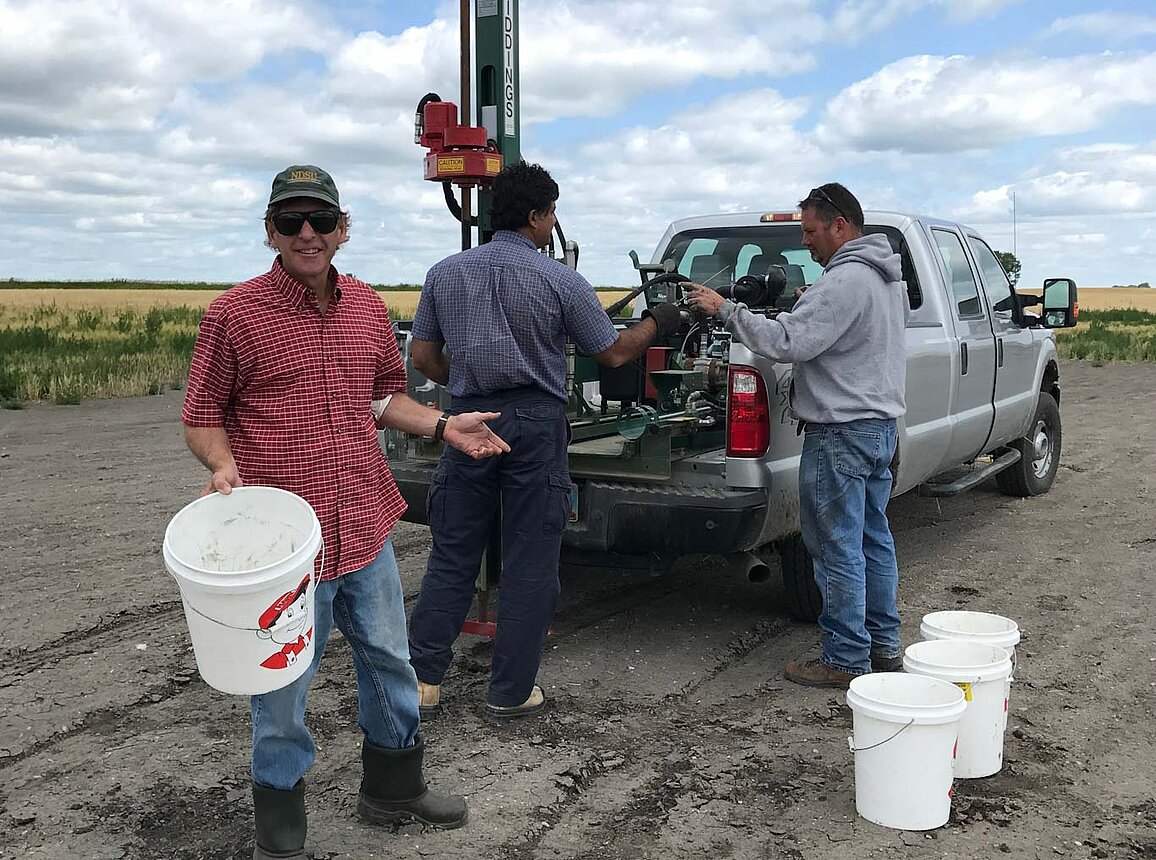Testing Grounds: How NDSU is Helping Bring Productivity Back to Salty Soils

Of the 39 million acres of cropland in North Dakota, nearly 15% has reduced productivity due to soil salinity and sodicity issues, costing North Dakota producers millions of dollars annually as affected areas produce very little to no crops.
Remediation of these issues involves applying soil amendments such as gypsum and establishing salt-tolerant plantings based on site-specific soil testing.
Analyzing soil salinity requires sampling zero to 3 or 4 feet deep, but most soil probes only can sample 2 feet deep.
“Until 2017, NDSU Extension specialists and agents helped producers sample to 4-foot depths with a hand-held auger, but this was time-consuming and required a lot of labor,” says Naeem Kalwar, NDSU Extension soil health specialist at the Langdon Research Extension Center (LREC). “We saw the need for a better system that would expand our soil testing capabilities to more producers at a faster pace.”
In 2018, the LREC purchased a pickup-mounted soil probe for the NDSU Extension soil health team’s use. Since that time, Kalwar and other Extension specialists and agents have conducted 197 soil tests for 68 landowners in 11 counties.
“We don’t stop at soil testing,” says Kalwar. “We discuss their individual test results, make recommendations and then continue to follow up. Many times, a soil test is the start of a long-term, trusted relationship.”
Alsen, N.D., farmer Mark Cheatley appreciates the soil testing and recommendations Kalwar makes. Eleven site-specific samples were taken at Cheatley Farm.
“Though it takes five to seven years to see remediation efforts work, I’m confident we will see results based on Extension’s research and Naeem’s experience using gypsum,” says Cheatley. “My father was a believer in Extension and I’ve continued to utilize their resources to make my operation more profitable.”
Much of the remediation work using gypsum is based on previous North Dakota Agricultural Experiment Station (NDAES) research. Since 2009, Tom DeSutter, a professor of soil science in NDSU’s School of Natural Resource Sciences, has studied how the application of flue gas desulfurization gypsum (FGDG), a by-product of the coal industry, can be used to remediate sodic soils. In addition, DeSutter worked with multiple state agencies to obtain the proper permitting for FGDG use.
In 2014, DeSutter and his team of NDAES scientists continued their research by studying the effect of FGDG on soil chemistry and wheat grain quality. The research confirmed that applying FGDG to sodic soils for remediation had no negative effects on soil chemistry or wheat quality.
Using DeSutter’s research, Kalwar, along with North Dakota Rep. David Monson and former U.S. Sen. Heidi Heitkamp, worked with the state’s coal industry to turn this coal by-product, FGDG, into agricultural-grade gypsum.
Thanks to their work, this widely used soil amendment was as much as $300 per ton but now is $5 per ton plus trucking.
FOR MORE INFORMATION:
www.ag.ndsu.edu/publications/crops/managing-saline-soils-in-north-dakota
www.ag.ndsu.edu/publications/crops/soil-testing-unproductive-areas
Naeem Kalwar, 701-256-2582, naeem.kalwar@ndsu.edu


